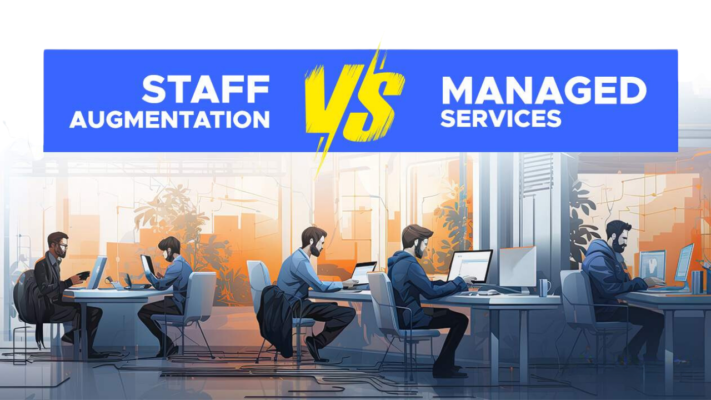
In today’s fast-paced and ever-evolving business landscape, organizations are constantly seeking ways to optimize their operations, streamline processes, and enhance their technological capabilities. Two popular approaches that have emerged to address these needs are IT staff augmentation and managed IT services. Each model offers unique advantages and caters to specific business requirements. In this comprehensive blog post, we’ll delve into the intricacies of staff augmentation vs managed services, exploring their definitions, types, pros and cons, and helping you determine which approach is the right fit for your organization.
What Is IT Staff Augmentation?
IT staff augmentation is a flexible staffing model that allows organizations to supplement their existing workforce with skilled IT professionals on a temporary or project-based basis. This approach enables businesses to access specialized expertise and resources without the need for permanent hires. By augmenting their teams with external talent, companies can quickly scale up or down according to their project demands, ensuring optimal resource allocation and cost-effectiveness.
Types of Staff Augmentation:
1. Onsite Staff Augmentation: In this model, the augmented IT professionals work alongside the client’s in-house team at their physical location. This approach facilitates seamless collaboration, knowledge transfer, and direct supervision.
2. Offsite Staff Augmentation: Also known as remote staff augmentation, this model involves augmented IT professionals working remotely from a different location, often leveraging collaboration tools and communication platforms.
3. Hybrid Staff Augmentation: This approach combines elements of both onsite and offsite models, allowing for a flexible arrangement where augmented staff can work from various locations as per project requirements.
Pros and Cons of the IT Staff Augmentation Model:
Pros:
- Flexibility and Scalability: Staff augmentation allows organizations to quickly scale their IT teams up or down based on project demands, minimizing the need for permanent hires and reducing overhead costs.
- Access to Specialized Expertise: By augmenting their teams, businesses can tap into a pool of highly skilled and specialized IT professionals with niche expertise, without the need for extensive training or recruitment efforts.
- Cost-Effectiveness: Staff augmentation often proves to be a more cost-effective solution compared to hiring full-time employees, as organizations only pay for the services they require, avoiding the additional costs associated with benefits, training, and overhead.
- Faster Time-to-Market: By quickly onboarding augmented staff, organizations can accelerate project timelines and ensure quicker delivery of products or services to the market.
Cons:
- Potential Communication Challenges: Integrating augmented staff with existing teams may pose communication and collaboration challenges, especially in offsite or hybrid models, potentially leading to misalignments or inefficiencies.
- Knowledge Transfer Concerns: When augmented staff leave after project completion, there is a risk of knowledge drain, as their specialized expertise may not be fully transferred to the in-house software development team.
- Cultural Fit and Integration: Integrating external professionals into an organization’s culture and workflows can be challenging, potentially leading to misunderstandings or conflicts if not managed effectively.
- Intellectual Property (IP) Considerations: Organizations must carefully manage IP rights and ensure that augmented staff adhere to confidentiality and non-disclosure agreements to protect sensitive information or proprietary technologies.
What Is Managed IT Services?
Managed IT services refer to the outsourcing of IT operations and responsibilities to a third-party service provider. In this model, the service provider assumes responsibility for managing, monitoring, and maintaining an organization’s IT infrastructure and systems. This approach allows businesses to focus on their core competencies while benefiting from the expertise and resources of specialized IT service providers.
Types of IT Managed Services:
1. Remote Monitoring and Management: This type of managed service involves the continuous monitoring and management of an organization’s IT infrastructure, including servers, networks, and applications, remotely by the service provider.
2. Cloud Services Management: As more businesses migrate to cloud-based solutions, managed cloud services providers offer expertise in deploying, configuring, and managing cloud environments, ensuring optimal performance and security.
3. Cybersecurity Services: Managed security services providers specialize in protecting organizations from cyber threats, offering services such as threat detection, incident response, and vulnerability management.
4. Help Desk and End-User Support: Managed service providers can offer comprehensive help desk and end-user support services, ensuring prompt resolution of technical issues and efficient user assistance.
5. IT Consulting and Advisory Services: Some managed service providers offer IT consulting and advisory services, providing strategic guidance on technology adoption, optimization, and alignment with business objectives.
Pros and Cons of IT Managed Services:
Pros:
- Access to Expertise and Resources: By outsourcing IT operations to specialized service providers, organizations can benefit from a wealth of expertise, cutting-edge technologies, and robust IT infrastructure without significant capital investment.
- Predictable Cost Structure: Managed IT services often follow a predictable pricing model, such as a fixed monthly fee, allowing organizations to better plan and budget their IT expenses.
- Improved Operational Efficiency: By offloading IT responsibilities to service providers, organizations can streamline their operations and focus on their core business activities, potentially improving overall efficiency and productivity.
- Proactive Maintenance and Support: Managed service providers typically offer proactive monitoring, maintenance, and support services, helping to prevent IT issues before they occur and ensuring minimal downtime.
- Compliance and Security: Reputable managed service providers prioritize compliance with industry regulations and implement robust security measures to safeguard their clients’ data and systems.
Cons:
- Loss of Control: By outsourcing IT operations, organizations may experience a perceived loss of control over their IT infrastructure and processes, which can be a concern for some businesses.
- Dependence on the Service Provider: Organizations become dependent on the managed service provider’s performance, reliability, and continuity of service, which can pose risks if the provider fails to meet expectations.
- Potential Data Security Concerns: While managed service providers implement security measures, some organizations may have concerns about entrusting sensitive data and systems to a third-party provider.
- Customization Limitations: Managed service offerings may not always be easily customizable to accommodate unique organizational requirements or processes, potentially leading to compromises or additional costs.
- Vendor Lock-in: Once an organization commits to a managed service provider, it can be challenging and costly to switch providers due to potential data migration, integration, and contractual constraints.
IT Staff Augmentation vs. Managed Services: Which to Choose?
When deciding between staff augmentation vs managed services, organizations must carefully evaluate their specific needs, priorities, and resources. Here are some key considerations to help guide the decision-making process:
1. Project Scope and Duration: If the IT requirements are temporary or project-based, staff augmentation may be the more suitable option, allowing for flexible scaling and cost-effectiveness. However, if the IT needs are ongoing and long-term, managed services could provide a more sustainable and comprehensive solution.
2. In-house Expertise and Resources: Organizations with robust in-house IT teams and resources may prefer staff augmentation to complement their existing capabilities, while those with limited internal IT resources may find managed services more beneficial for outsourcing a significant portion of their IT operations.
3. Control and Oversight: If maintaining direct control and oversight over IT operations is a priority, staff augmentation may be the preferred choice, as it allows for closer integration and supervision of augmented staff. Managed services, on the other hand, offer less direct control but provide the benefit of expert oversight and management by the service provider.
4. Cost Considerations: While staff augmentation can be more cost-effective for short-term or project-based needs, managed services may offer more predictable and potentially lower costs for ongoing IT operations, especially for organizations with limited internal IT resources.
5. Compliance and Security Requirements: For businesses operating in highly regulated industries or dealing with sensitive data, managed services provided by specialized providers may offer a more robust and compliant solution for meeting stringent security and compliance requirements.
6. Strategic Alignment: If the IT requirements align closely with the organization’s core competencies and strategic objectives, staff augmentation may be the preferred approach to maintain control and alignment. Conversely, if IT is not a core focus, managed services could be a viable option to offload non-essential IT operations and focus on strategic priorities.
It’s important to note that these considerations are not mutually exclusive, and in some cases, organizations may opt for a hybrid approach, combining elements of staff augmentation and managed services to meet their unique needs effectively.
Conclusion:
In the dynamic realm of IT, organizations face the challenge of balancing operational demands, resource constraints, and strategic objectives. The decision between staff augmentation vs managed services ultimately depends on a range of factors, including project scope, in-house capabilities, cost considerations, compliance requirements, and strategic alignment.
Staff augmentation offers flexibility, scalability, and access to specialized expertise, making it an ideal choice for organizations with robust in-house IT teams and project-based or temporary IT needs. On the other hand, managed services provide comprehensive IT operations management, predictable costs, and access to cutting-edge technologies, well-suited for organizations with limited internal IT resources or long-term, ongoing IT requirements.
Ultimately, the right approach will be the one that aligns with your organization’s unique needs, priorities, and strategic objectives. In some cases, a hybrid model combining elements of staff augmentation and managed services may be the most effective solution.
It’s crucial to carefully evaluate your organization’s specific requirements, weighing the pros and cons of each approach, and consult with IT experts to make an informed decision. Partnering with a reputable and experienced technology consulting firm like Upcore Technologies can provide valuable insights and guidance to help you navigate the complexities of staff augmentation vs managed services.
Upcore Technologies, with its team of skilled professionals and deep industry experience, can assist you in assessing your IT needs, analyzing the potential benefits and drawbacks of each approach, and developing a tailored strategy that optimizes your IT operations, enhances efficiency, and drives business growth.
By leveraging Upcore Technologies’ expertise, you can ensure that your organization adopts the right IT service delivery model, whether it’s managed or staff augmentation services, or a hybrid solution, aligning your technological capabilities with your business goals and paving the way for long-term success in an ever-evolving digital landscape.


